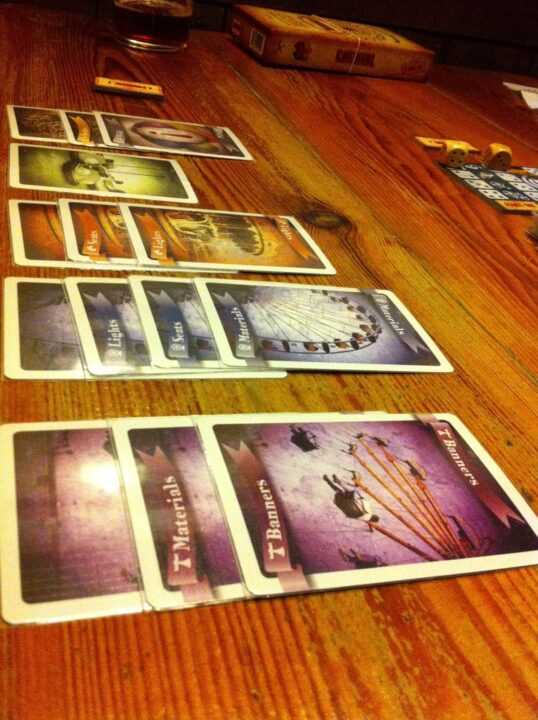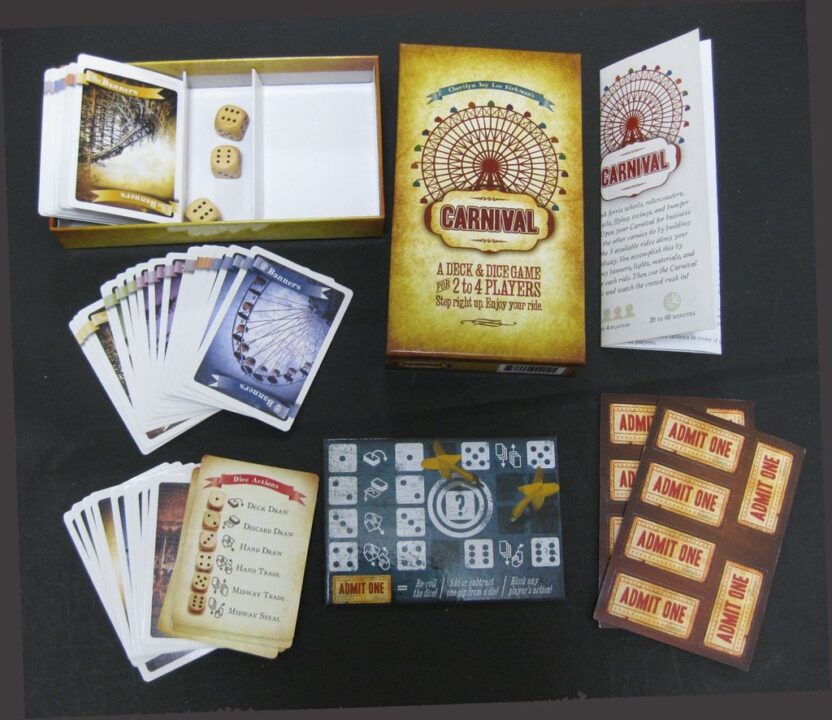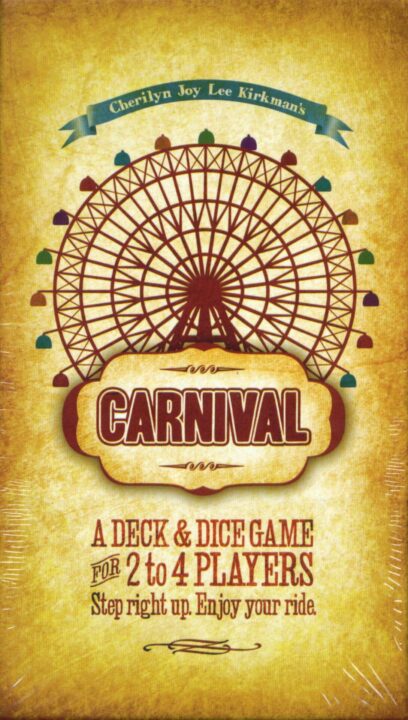If you’ve ever wanted to run away with the circus without the risk of being chased by clowns, you’re in luck—because I actually played Carnival with my friends, and here’s my honest review. Strap in for a wild ride through a game that throws dice, trade, and a whole lot of cardboard your way. I’ll cover what’s fun, what’s a flop, and whether this luck-fueled carousel is worth your tokens. Let’s get started!
How It Plays
Setting Up
First, hand everyone a player board and five empty ticket booths. Shuffle the deck and give each player four cards. Place the parts deck in the center, and lay out the parts wheel. Give each player three coins. Put the dice close by (you’ll need them!).
Gameplay
On your turn, roll both dice. The combo tells you which carousel tickets you can snag or what trades you can make. You’ll use your cards to collect sets of ride parts, but you might also end up swapping or stealing from friends. (There will be drama. I promise.) Turns go fast, since you just roll, get your part, and curse your luck. Or plot revenge. Up to you.
Winning the game
The first player to finish building all five attractions on their board is the winner. You’ll need a full set of parts for each ride, but beware—opponents can snatch away the pieces you need. If you finish all five, stand up, do a victory lap, and gloat. (Not actually in the rules, but I recommend it.)
Want to know more? Read our extensive strategy guide for Carnival.
Game Mechanics and Fairness in Carnival: Luck or Skill?
If you ever wanted to know how fair Carnival is, let me assure you, I’ve played it more times than I’ve eaten popcorn at the real deal. This game is all about building your own set of rides before your rival carnies do. Sounds easy, right? Well, sort of.
The mechanics are simple enough for a half-asleep uncle at a family BBQ to understand. You roll dice to get parts for your rides, and then trade or steal from each other to complete your set. Here’s the thing—those dice can be friendlier than your grandma, or they can turn on you fast. The luck factor is high, so sometimes you’ll breeze through, and other times you’ll stare at the dice like they owe you money.
Trading adds a bit more choice and backstabbing—I mean, strategic play. You can haggle, wheedle, or full-on plead for the last piece of the Tilt-A-Whirl, but if you don’t roll what you need, you’re basically stuck. It’s fun but can get frustrating, especially if someone at the table gets a huge lead because their dice just love them more.
On the fairness side, Carnival tries, but the heavy dash of luck can make it feel like a rigged ring toss at times. If you want a game where the best player always wins, this isn’t it. But if you like a bit of chaos and a lot of laughs, you’ll have a good time.
Next, I’ll talk about the artwork and components—because if you’re gonna lose to the dice, at least the board should look pretty, right?

Carnival’s Artwork and Components: Eye Candy or Clown Car?
Let’s get something straight—Carnival is not the slickest show in town, but it’s not a rusty tilt-a-whirl either. The artwork is bursting with colors. It makes my living room table look like a candy shop exploded (in a good way). Cards feature classic carnival attractions, from Ferris wheels to creepy clowns. My friend Ben, who’s terrified of clowns, kept flipping his over so he wouldn’t have to look at them. I guess it’s immersive?
The card stock is solid, not flimsy, so shuffling doesn’t feel like you’re tearing up a paper napkin. I’ve played with my ham-fisted cousin, and even he didn’t manage to bend one the whole game. The tickets you trade are thick and easy to pick up, unless you have those long nails like my friend Sally. She kept catapulting pieces across the table.
The tokens and bits are cute, though a few seemed a little mismatched. The plastic is sturdy, but don’t expect the smooth finish of a fancy Euro. It’s more ‘popcorn bucket’ than ‘fine porcelain’. Boxes fit everything nicely, and the rulebook is full color so you don’t lose your mind squinting. I did wish for player aids since your first game will probably include a lot of ‘wait, what does this card do again?’ moments. But hey, you can always make your own if you enjoy arts and crafts (I don’t, I’m not Picasso).
Next up, we’ll see if you’ll want to ride this carousel over and over, or if Carnival just sits on your shelf like a stuffed animal nobody actually wanted to win.

Replay Value and Player Interaction in Carnival
When I first set up Carnival with my group, I thought the replay value would be low. It’s a game about building your own carnival, after all—how many times can you arrange a Ferris wheel before your brain starts spinning? My friend Joel, who once tried to play chess against his cat, said we’d be bored after two goes. But, surprise! Carnival has some neat tricks up its sleeve.
The game gives you lots of little decisions every turn. Will you swap a card with another player, or keep your hand secret? Do you go for matching sets, or try to block someone else’s roller coaster? The trading and sabotage moments made us cackle like goblins, especially when someone pulled off a perfect steal. Player interaction is in your face—in a good way. Everyone is eyeing each other’s carnival parts and groaning when their plans get wrecked. This is not a solo puzzle; it’s like playing whack-a-mole, where you are the mole sometimes.
The replay value depends a lot on your group. If you’ve got people who like to mess with each other (my brother, for example, who once hid the Monopoly money in the fridge), you’ll get a kick out of it. Some strategies work better than others, but there’s enough chaos that no two games are quite the same. If you want a brain-burner, this won’t be your top pick, but for light fun and smack talk, Carnival delivers a decent replay punch.
I hope you like your games unpredictable, because next up I’ll spill the beans on Carnival’s luck versus strategy balance!
Carnival: Is It Skill or Just the Luck of the Draw?
Now, let’s talk about the great board game debate: luck versus strategy. When my friends and I set up Carnival, we all had big plans. We wanted to outwit each other and become the carnival tycoon. Sadly, the real master at our table turned out to be a six-sided die.
Carnival relies on dice rolling to let you take actions. Want to build a Ferris wheel? Hope you roll what you need! Want to steal a part from a rival? Better roll those magic numbers. This can lead to some wild moments—like when my friend Dave, the self-proclaimed “King of the Carnival,” spent three turns trying to get just one needed part. The rest of us? We started calling him “Clown Shoes.”
While there are choices to make—like trading cards or picking which rides to focus on—the dice rule the show. Sometimes, it feels less like building a grand fair and more like hoping you win the lottery in clown makeup. If you love games where your brain gets a workout, Carnival might drive you a little bananas. I tried forming a fancy plan once, only to watch it crash and burn thanks to two terrible dice rolls. Turns out, I’m not a lucky person. Who knew?
If you and your group are all about goofy fun, sudden upsets, and loud groaning when luck deserts you, Carnival delivers big time. But if you want strategy and skill to shine, you may want to check out other games. I had a blast, but I only recommend Carnival if you know what you’re getting: a wild, luck-heavy ride that’s more silly than smart!
Conclusion
Alright, that wraps up my wild ride with Carnival. This game stands out for its colorful art, easy rules, and lighthearted fun. My group had plenty of laughs and a few groans when luck turned against us. If you want a light, silly game that moves fast and feels a bit like bumper cars at the fair, you’ll have a good time. But if you crave deep strategy or get cranky when dice hate you, you might want to try something else. For families and groups who don’t mind a bit of chaos, Carnival can hit the spot. Thanks for sticking with me for this review—I hope it helps you decide if this is your kind of fun!


